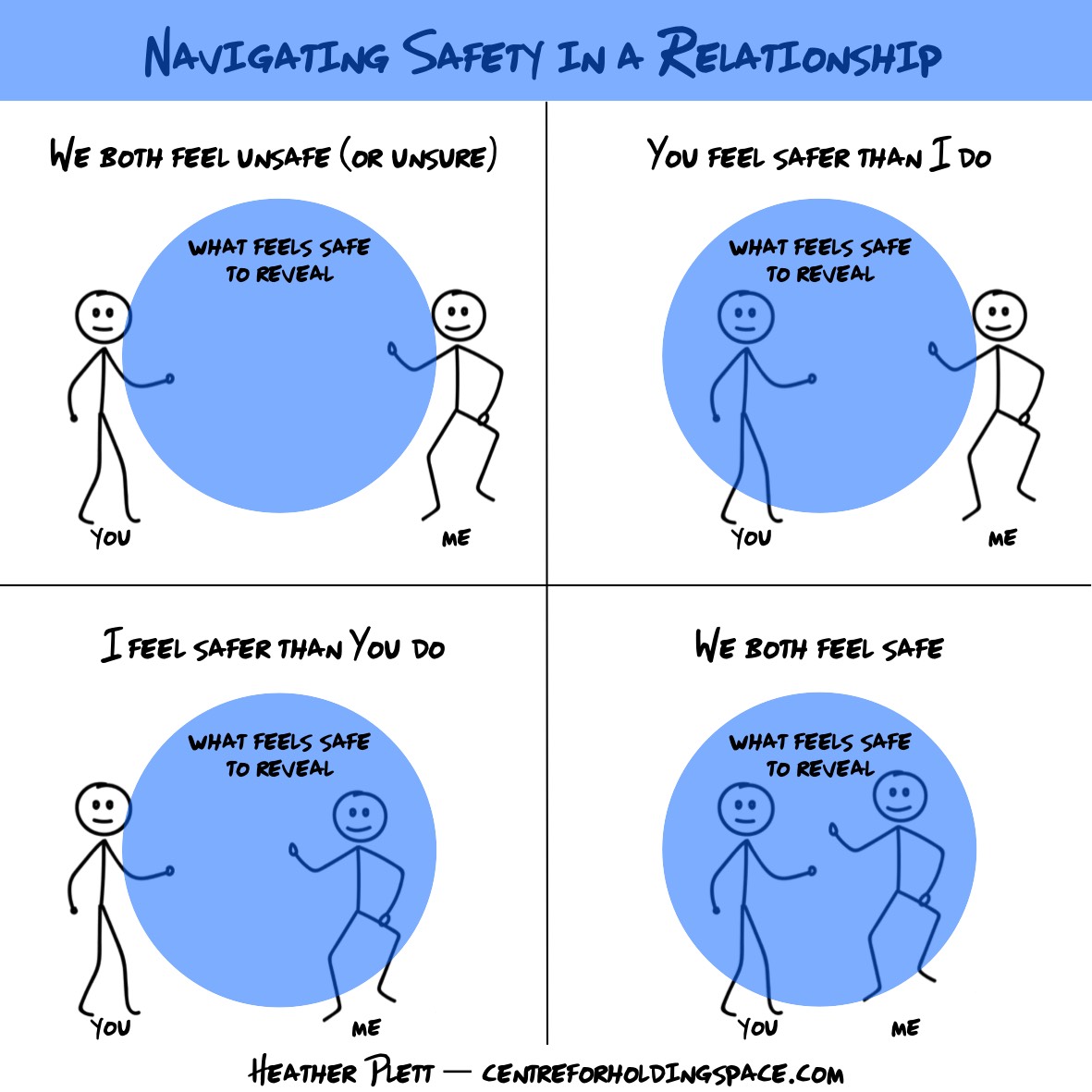Authenticity and vulnerability – those are two buzzwords we talk about a lot in personal growth and community development work. Most of us know how important they both are, and so we strive to embrace them. But… there’s an important aspect that is sometimes missing from the conversation: emotional safety.
It can be very difficult, and sometimes even dangerous, to be authentic and vulnerable when emotional safety is not available.
Emotional safety is a concept most commonly used in attachment theory. When we feel emotionally safe, our nervous systems are calm, we are able to put our trust in other people, we can access the parts of our brains that are rational rather than reactive, we have better access to the full range of our emotions and feel safe expressing them, and we’re more able to take healthy risks because we’re not in hypervigilance mode.
People who’ve experienced little or no trauma and/or have grown up in family systems that are safe and supportive, where they were able to develop secure attachment styles, usually have more access to emotional safety than those with trauma and dysfunctional family systems. Some people (i.e. those with c-PTSD) may rarely, if ever, feel emotionally safe, especially if they have not had therapeutic support in healing their trauma.
Those with trauma and anxious or avoidant attachment styles are almost always scanning the environment for what is unsafe and, even in the most ordinary, quiet moments (and sometimes ESPECIALLY in those quiet moments), their nervous systems can’t settle enough for them to trust that harm isn’t just around the corner. They may appear calm to any observer, but on the inside, they’re looking for the escape route for whenever chaos erupts.
Emotional safety is never guaranteed in a relationship, community, or situation. It can’t be manufactured, bought, or created with “ten easy steps”. We are all complex human beings with different needs, so there isn’t a one-size-fits-all guide to building emotional safety. It has to be grown and nurtured through intentional and often slow commitment, especially when there are people with trauma involved in the relationship or community. (And really… I tend to assume everybody I meet probably has some trauma, since there are few of us who’ve experienced none.)
Depending on the relationship and/or circumstances, emotional safety can fluctuate from day-to-day and even moment-to-moment. It exists on a spectrum, ranging from full-on terror and complete distrust to comfort and complete trust and ease. Some of us never reach the safe end of the spectrum and some of us are almost always hovering near the unsafe end.
Consider the diagram at the top of this post. In the first box, we have met as acquaintances and we don’t yet know whether emotional safety will be available to us in the relationship, so we don’t reveal too much of ourselves to each other. In the second box, perhaps because you’ve had less trauma than I have and you feel that I’ve met your criteria for emotional safety, you reveal more of yourself to me. But I may have a more insecure attachment style, or maybe you remind me of someone who’s hurt me in the past, so I don’t reveal as much of myself to you. In the third box, the tables have turned and I have reason to trust you, but you are still somewhat leery, perhaps because I am your boss and have the power to use whatever you share with me to my advantage. In the fourth box, we’ve built enough trust in each other and have nurtured enough emotional safety for us both to reveal ourselves to each other.
(Note: This diagram is a generalization and doesn’t apply to all situations or people. Some of us tend to over-share or reveal inappropriate things about ourselves because of trauma or social anxiety or social conditioning. It’s also true that some of us are more naturally extroverted or introverted and so we have different tendencies when it comes to revealing ourselves to others.)
There are many things that get in the way of emotional safety. It might be trauma, fear, insecurity, or bias that one or both of us carry into the relationship. Or it might be a behaviour or choice on one of our parts that damages trust and jeopardizes emotional safety. There might also be some systemic issues involved (i.e. imbalances because of gender, race, social hierarchy, etc.) that make one or both of us feel unsafe in the situation. Any of these things can have either short-term or long-term impact on emotional safety and some of them (especially when there’s harm done) require repair and reconciliation before emotional safety can be re-established.
It’s important to recognize that those who are not revealing themselves fully to other people aren’t necessarily living inauthentic lives (or avoiding vulnerability) – they are simply paying attention to their emotional safety signals and being discerning about what to reveal to whom. That’s not inauthentic, it’s wise boundary-setting and self-care.
There can be very good reasons why we don’t feel emotionally safe in certain circumstances and with certain people, and, instead of trying to banish that feeling we should examine it to see whether it’s something we should listen to or challenge. Many times, there are valuable clues available to us in our bodies telling us who is trustworthy and who is not, which situation we can lean into and which one we should run from – that’s the way our bodies are designed in order to keep us safe. This isn’t a bad thing – in fact, when we try to shut down the signals, sometimes we expose ourselves to abuse. But when we’ve got trauma in our bodies, our nervous systems become hyper-sensitive to any evidence of the lack of safety and then it can become a limiting factor in living a full life. That’s when it should be more fully explored.
We can try (as facilitators, coaches, therapists, pastors, teachers, friends, etc. usually do) to create conditions for safety, and we can try to make repairs when safety is jeopardized, but we can never guarantee it because we never know all the factors that are at play for a person. We usually don’t even recognize all the factors that are at play for ourselves, so it’s impossible to know it for others. I can think of many times, for example, when I was in a situation where I didn’t feel emotionally safe but wasn’t able to pinpoint a reason for it – it takes a lot of self-reflection to learn to recognize and understand all the things that trigger us to feel unsafe.
One of the challenges for creating conditions for emotional safety is that we haven’t developed a lot of language for it, and it’s often not acceptable to make the existence or lack of it explicit. As a result, people don’t know how to ask for what they need or identify what’s missing.
To become more proficient at recognizing it, naming it, and talking about it, start by paying attention to your own body’s signals about when you feel safe and when you don’t. When you learn to recognize it (i.e. perhaps your chest tightens, your head buzzes or your throat closes), then start asking yourself “what would I need in this moment in order to feel more emotionally safe?” When you’re ready, try articulating that need to a person you trust and (if appropriate) invite them to do the same. If you find someone who knows how to hold space for you while you explore what does and does not make you feel safe, you have found an immeasurably valuable thing.
If, when you’ve done honest reflection, you find that there are many situations where you do not feel emotionally safe, consider hiring a therapist who can help you unravel the reasons why you tend to stay in hyper-vigilance, reluctant to trust the people you’re in relationship with.
As you become more proficient at naming and talking about your own experience of emotional safety, you will become more empathetic about other people’s needs and limitations. You can start to model it for other people that you’re in relationship with (i.e. by articulating your needs, your boundaries, and your triggers) and you can create space for them to do likewise. Just remember not to push anyone further than they’re prepared to go.

